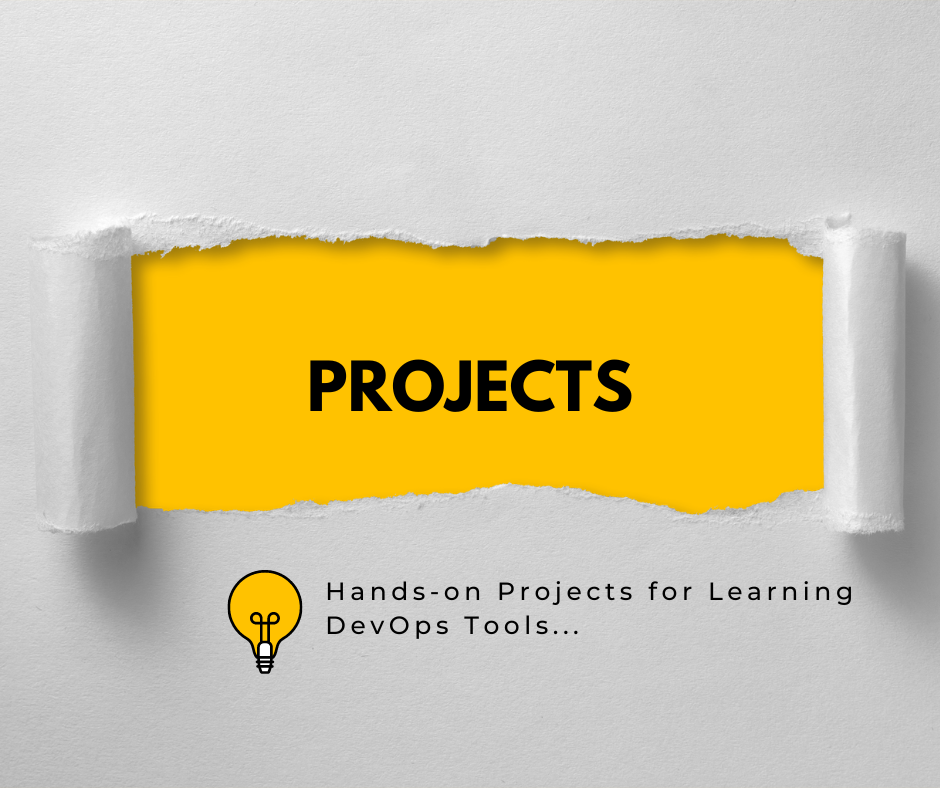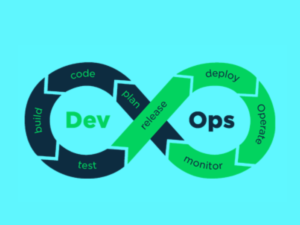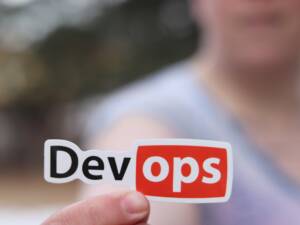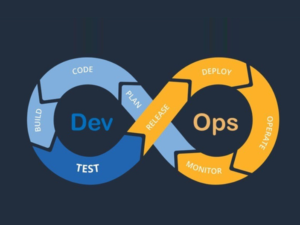DevOps Project Bank - Free for Trainees
- Description
- Curriculum
- Reviews

Why Enroll?
- Access to over 300 real-life projects: Explore our projects and build the confidence to succeed.
- Hands-on experience with the latest DevOps tools and techniques: Get first-hand experience with the tools and techniques that are shaping the DevOps landscape.
- Comprehensive program with a wealth of projects: Benefit from a program that provides a diverse range of projects, guides, and examples that will show you how to use different DevOps tools effectively.
- Real-world, practical projects: Gain a deep understanding of the latest DevOps best practices through real-world projects that cover various topics.
- Flexible and accessible: The program is designed to be flexible and accessible, with step-by-step guides and clear examples that make it easy to get started.
- Take your DevOps skills to the next level: Whether you’re a seasoned professional or just starting out, the DevOps Project Bank has something for everyone. With its comprehensive approach, you will take your skills to the next level.
Our Scope
Our project bank includes a wide range of tools commonly utilized in the domains of DevOps and platform engineering. These tools include but are not limited to:
- Linux Commands for deployment on Linux servers
- Shell Scripting for process automation
- Git and GitHub for version control and collaboration
- Maven for building and managing Java-based projects
- SonarQube for code quality analysis and continuous inspection
- Tomcat for running Java web applications
- Apache HTTP server and Nginx for web server functionality
- Nexus for managing artifact repositories
- Jenkins for continuous integration and delivery
- Ansible for automation and orchestration of IT infrastructure
- AWS for cloud computing and storage
- Terraform for infrastructure as code
- Docker for containerization of applications
- Kubernetes for container orchestration
- FluxCD for GitOps-style continuous delivery
- ArgoCD for GitOps-based continuous delivery
- Helm for managing Kubernetes applications
- Mulesoft Anypoint for integration and API management
- Monitoring tools like New Relic, Prometheus, and Grafana for observability and performance analysis
- Crossplane for multi-cloud control plane management
- Kratix for Kubernetes-native DevOps platform
- Ambassador for API gateway and Kubernetes-native microservices management
- Cycloid for DevOps automation platform and infrastructure management
- Port for cloud-native development and application deployment
- Backstage for managing and sharing developer services and tools
- configure8 for configuration management and infrastructure automation
- Humanitec for Kubernetes-native application development platform
- Upbound for multi-cloud control plane and service automation
- Qovery for PaaS and deployment automation.
Don’t miss this opportunity to enhance your DevOps skills! Enroll in the DevOps Project Bank today!
The DevOps Project Bank is FREE for those enrolled in any of our paid DevOps programs, making it an unbeatable opportunity to grow your skills.
Step-by-Step Guide to setting up an account:
- Click on SIGN UP to access the registration page.
- Fill in the required personal information, such as your name, email address, and password.
- Click on the “Register” button to complete the registration process.
- Log in to your account using your email address and password.
If you are a returning user, simply login to your account using your email address or username and password.
5. Once you are logged in, click on the “Get Course” button to enroll in the program.
- After enrolling in the course, click on the “Curriculum” tab to access the projects.
- Start learning and make the most of the program!
>>> Linux & Shell Scripting Projects
>>> Git & GitHub Projects
-
11Git Repository and your Local Machine
-
12Adding Files to the Git Repository
-
13Branching and File Modification
-
14Merging Changes across Branches
-
15Pushing to a Remote Repository
-
16Pull Requests and Code Review
-
17Collaboration and Code Review
-
18User Management & Repositories
-
19Tracking Changes and Rolling Back
-
20Resolving Merge Conflicts
-
21Deploying a Website to a Hosting Platform
-
22Managing Source Code for a Project
-
23Tracking Changes to Configuration Files
-
24Tracking Changes to Documents
-
25Managing Blog/Website Content
-
26Tracking Changes to a Data Set
-
27Managing Assets for a Project
-
28Tracking Changes to Slides
-
29Managing Resources for a Game
-
30Tracking Changes to a Research Paper
>>> Maven Projects
-
31Creating and Building a Java Project
-
32Adding Dependencies to Project
-
33Multi-module Maven Project
-
34Packaging a JAR File
-
35Packaging a WAR File
-
36Building and Running Unit Tests
-
37Using JaCoCo for Code-coverage Reports
-
38Using javadoc to Generate Documentation
-
39Using Checkstyle to Generate Static Analysis Report
-
40Using Selenium to run Integration Tests
-
41Deploying to a Remote Repository
-
42Using Spotify to Create Docker Image
-
43Using Assembly to Create a Distribution Package
-
44Using Release to Generate a Release
-
45Using JMeter to run Performance Tests
-
46Using SonarQube to Generate Reports
-
47Using Jenkins as a CI Server
-
48AWS Deployment
-
49Azure Deployment
-
50GCP Deployment
-
51Using Ansible to Automate Deployment
-
52CD with Jenkins
-
53CD with GItLab CI
>>> Tomcat Projects
-
54Tomcat and your Local Machine
-
55Java Web Application Deployment
-
56Port Change
-
57Using SSL for Secure Connection
-
58Virtual Host Configuration
-
59Load Balancing
-
60Serving Static Content
-
61Serving Content using Java Servlet
-
62Serving Content using JSP File
-
63Serving Content using JSF Application
-
64Serving Content using Java Web Service
-
65Serving Content using RESTful Web Service
-
66Deployment using WAR File
-
67Deployment using an Exploded Directory
-
68Deployment using Manager Web Application
-
69Setting up a Connection Pool
-
70Setting up a Database Connection
-
71Setting up Security using Login Form
-
72Setting up Security using LDAP
-
73Setting up Security using Client Certificate
>>> Webservers Projects
-
74Apache and your Local Machine
-
75Nginx and your Local Machine
-
76Setting up a Virtual Host
-
77Serving Static Content
-
78Serving Content using PHP or Python
-
79Setting up Reverse Proxy
-
80Serving Content over SSL/TLS
-
81Serving Content from a Load-Balanced Cluster
-
82Serving Content from a CDN
-
83Serving Content from a Cloud Storage Service
-
84Serving Content from a Database
-
85Setting up URL Rewriting
-
86Setting up Custom Error Pages
-
87Setting up Logging for Performance Tracking
-
88Setting up Caching
-
89Setting up Compression
-
90Setting up Firewall
-
91Setting up a Load Balancer
-
92Setting up a Monitoring System
-
93Setting up a CICD Pipeline
-
94Setting up a Continuous Delivery Pipeline
>>> SonarQube Projects
-
95Simple Java Project using SonarQube.
-
96Detection of code smells
-
97Detection of Vulnerabilities
-
98Detection of Security Issues
-
99Detection of Bugs
-
100Detection of Code Duplications
-
101Detection of Code Coverage Issues
-
102Detection of Test Issues
-
103Detection of Technical Debt
-
104Detection of Performance Issues
-
105Detection of Maintainability Issues
-
106Detection of Reliability Issues
-
107Detection of Documentation Issues
-
108Detection of Style Issues
-
109Detection of Complexity Issues
-
110Detection of Compliance Issues
-
111Detection of Architecture and Design Issues
-
112Issues Detection using Custom Rules
-
113Static Analysis and CI Pipeline
>>> Nexus Projects
-
114Nexus and your Local Machine
-
115Repository for Maven artifacts.
-
116Repository for Docker images.
-
117Repository for npm packages.
-
118Repository for Python packages.
-
119Repository for NuGet packages.
-
120Repository for Ruby gems.
-
121Repository for RPM packages.
-
122Repository for Debian packages.
-
123Repository for Helm charts.
-
124Repository for raw files.
-
125Repository for GitHub packages.
-
126Repository for GitLab packages.
-
127Repository for BitBucket packages.
-
128Repository for Ansible Galaxy collections.
-
129Repository for Puppet modules.
-
130Repository for Chef cookbooks.
-
131Repository for Terraform modules.
-
132Repository for Vagrant boxes.
-
133Repository for Kubernetes operator bundles.
>>> Jenkins Projects
-
134Jenkins and your local machine.
-
135Build a simple project
-
136Running unit tests for a project.
-
137Running integration tests for a project.
-
138Build and deploy a web application.
-
139Automation of application deployment to a cloud platform
-
140Deployment of a Docker container.
-
141Deployment of a Kubernetes application.
-
142Setting up a continuous integration pipeline for a project.
-
143Setting up a continuous delivery pipeline for a project.
-
144Triggering builds based on events
-
145Scheduling Builds
-
146Setting Notifications
-
147Setting up security for a Server
-
148Managing Agent Nodes
-
149Setting up 3rd-Party Plugins
-
150Defining Pipeline as Code
-
151Setting up Shared Libraries
-
152Defining Complex Pipelines
-
153Using Blue Ocean for Pipeline Creation
>>> AWS Projects
-
154Setting up an AWS Account
-
155Creating and Configuring an Instance
-
156Hosting a Simple Website
-
157Deployment using Elastic Beanstalk
-
158Storing and retrieving files using S3
-
159Running a Code with AWS Lambda
-
160Storing and Retrieving Data using DynamoDB
-
161Managing Amazon RDS
-
162Setting up a Message Queue
-
163Sending Notifications using SNS
-
164Managing Users and Permissions
-
165Managing Resources using CloudFormation
-
166Setting up CD Pipeline with CodePipeline
-
167Building a Code with CodeBuild
-
168Deploying a Code with CodeDeploy
-
169Debugging & Optimizing Applications
-
170Monitoring Resources and Applications
-
171Automatically Scale Resources Based on Demand
>>> Terraform Projects
-
172Terraform and your local machine
-
173Terraform and AWS Resources
-
174Terraform and GCP Resources
-
175Terraform and Azure Resources
-
176Terraform and DigitalOcean Resources
-
177Terraform and Kubernetes Cluster Resources
-
178VPC with Terraform
-
179S3 Bucket with Terraform
-
180EC2 Instances with Terraform
-
181Load Balancer with Terraform
-
182Security Group with Terraform
-
183RDS with Terraform
-
184DynamoDB Table with Terraform
-
185Lambda Function with Terraform
>>> Ansible Projects
-
186Ansible and your local machine.
-
187Running ad-hoc commands
-
188Managing packages and services
-
189Managing users and groups
-
190Managing files and directories
-
191Managing templates to create configuration files
-
192Managing cron jobs
-
193Managing firewall rules
-
194Managing a Database
-
195Managing a Web Server
-
196Managing a Load Balancer
-
197Managing a Message Queue
-
198Managing a Cache
-
199Managing a CI Server
-
200Managing a CD Pipeline
-
201Managing a Kubernetes Cluster
-
202Managing a Cloud Infrastructure
-
203Managing a Network Infrastructure
-
204Managing a Storage Infrastructure
-
205Managing a Security Infrastructure
>>> New Relic Projects
-
206Setting up New Relic
-
207Installation and configuration of New Relic agent
-
208Monitoring the performance of a web server
-
209Monitoring the performance of a web application
-
210Monitoring the performance of a database
-
211Monitoring the performance of a message queue
-
212Monitoring the performance of a cache
-
213Monitoring the performance of a load balancer
-
214Monitoring the performance of a network
-
215Monitoring the performance of a cloud infrastructure
-
216Setting up alerts for performance issues
-
217Troubleshooting Performance Issues
-
218Optimizing the performance of a web application
-
219Optimizing the performance of a database.
-
220Optimizing the performance of a message queue.
-
221Optimizing the performance of a cache.
-
222Optimizing the performance of a load balancer
-
223Optimizing the performance of a network
-
224Optimizing the performance of a cloud infrastructure
-
225Optimizing the performance of a system
>>> Docker Projects
-
226Docker on your local machine.
-
227Running a simple web server
-
228Running a Database
-
229Running a message queue
-
230Running a Cache
-
231Running a Load Balancer
-
232Running a continuous integration server
-
233Running a continuous delivery pipeline
-
234Running a batch processing job
-
235Running a machine learning model
-
236Running a Microservice
-
237Running a network of interconnected containers
-
238Building and publishing a custom image
-
239Defining and running multi-container applications
-
240Setting up and managing a cluster
-
241Setting up and using a registry to store images
-
242Setting up and using a volume to persist data
-
243Setting up and using a network for connection
-
244Setting up and using plugins to extend functionalities
-
245Setting up and using security tool to assess security
>>> Kubernetes Projects
-
246Kubernetes on a local machine
-
247Deployment of a simple web server
-
248Deployment of a database
-
249Deployment of a message queue
-
250Deployment of a cache
-
251Deployment of a load balancer
-
252Deployment of a continuous integration server
-
253Deployment of a continuous delivery pipeline
-
254Deployment of a batch processing job
-
255Deployment of a machine learning model
-
256Deployment of a microservice
-
257Deployment of a network of interconnected containers
-
258Managing the deployment and scaling of applications.
-
259Managing Services to expose applications
-
260Managing Ingress to control access to applications
-
261Managing Volumes to persist data
-
262Managing ConfigMaps and Secrets
-
263Managing Namespaces to isolate resources
-
264Managing RBAC for access control.
-
265Managing Operators to automate applications management
>>> Helm Projects
-
266Helm on your local machine
-
267Deploy a simple web server
-
268Deploy a database
-
269Deploy a message queue
-
270Deploy a cache
-
271Deploy a load balancer
-
272Deploy a continuous integration server
-
273Deploy a continuous delivery pipeline
-
274Deploy a batch processing job
-
275Deploy a machine-learning model
-
276Deploy a microservice
-
277Deploy a network of interconnected containers
-
278Create and manage Helm Charts for deploying applications.
-
279Manage dependencies between charts.
-
280Parameterize charts for customization.
-
281Store charts in a repository.
-
282Use third-party charts
-
283Use custom values to override default values.
-
284Use template functions to customize templates
-
285Use helpers to simplify complex templates.
>>> Prometheus & Grafana Projects
-
286Prometheus and Grafana on a local machine.
-
287Scrape metrics from a web server.
-
288Scrape metrics from a database.
-
289Scrape metrics from a message queue.
-
290Scrape metrics from a cache.
-
291Scrape metrics from a load balancer.
-
292Scrape metrics from a continuous integration server.
-
293Scrape metrics from a continuous delivery pipeline.
-
294Scrape metrics from a batch processing job.
-
295Scrape metrics from a machine learning model.
-
296Scrape metrics from a microservice.
-
297Visualize metrics scraped by Prometheus.
-
298Set up alerts for metric thresholds.
-
299Create custom dashboards for visualizing metrics.
-
300Integrate with other data sources
-
301Use third-party plugins to extend functionality.
-
302Use custom variables to parameterize dashboards.
-
303Use custom templates for dashboard creation.
-
304Use Cloud for managed monitoring and alerting.
-
305Use Enterprise for advanced features and support.
>>> GitHub Actions Projects
-
306Understanding the workflow syntax.
-
307Set up a continuous integration (CI) pipeline for a web application.
-
308Set up a continuous delivery (CD) pipeline for a web application.
-
309Set up a CI/CD pipeline for a mobile application.
-
310Set up a CI/CD pipeline for a backend service.
-
311Set up a CI/CD pipeline for a DevOps tool.
-
312Set up a CI/CD pipeline for a cloud infrastructure.
-
313Set up a CI/CD pipeline for a network infrastructure.
-
314Set up a CI/CD pipeline for a storage infrastructure.
-
315Set up a CI/CD pipeline for a security infrastructure.
-
316Set up a CI/CD pipeline for a containerized application.
-
317Set up a CI/CD pipeline for a serverless application.
-
318Set up a CI/CD pipeline for a desktop application.
-
319Set up a CI/CD pipeline for an IoT application.
-
320Set up a CI/CD pipeline for an AR/VR application.
-
321Set up a CI/CD pipeline for a game application.
-
322Set up a CI/CD pipeline for a data processing job.
-
323Set up a CI/CD pipeline for a scientific computing application.
-
324Set up a CI/CD pipeline for an artificial intelligence application.
>>> Argo CD Projects
-
325Argo CD on a local Kubernetes cluster.
-
326Set up a continuous delivery (CD) pipeline for a web application.
-
327Set up a CD pipeline for a mobile application.
-
328Set up a CD pipeline for a backend service.
-
329Set up a CD pipeline for a machine-learning model
-
330Set up a CD pipeline for a DevOps tool.
-
331Set up a CD pipeline for a cloud infrastructure.
-
332Set up a CD pipeline for a network infrastructure.
-
333Set up a CD pipeline for a storage infrastructure.
-
334Set up a CD pipeline for a security infrastructure.
-
335Set up a CD pipeline for a containerized application.
-
336Set up a CD pipeline for a serverless application.
-
337Set up a CD pipeline for a desktop application.
-
338Set up a CD pipeline for an IoT application.
-
339Set up a CD pipeline for an AR/VR application.
-
340Set up a CD pipeline for a game application.
-
341Set up a CD pipeline for a data processing job.
-
342Set up a CD pipeline for a scientific computing application.
-
343Set up a CD pipeline for an artificial intelligence application.
-
344Set up and manage multiple CD pipelines for a complex application.
>>> FluxCD Projects
-
345Flux CD on a local Kubernetes cluster.
-
346Set up a continuous delivery (CD) pipeline for a web application.
-
347Set up a CD pipeline for a mobile application.
-
348Set up a CD pipeline for a backend service.
-
349Set up a CD pipeline for a machine-learning model.
-
350Set up a CD pipeline for a DevOps tool.
-
351Set up a CD pipeline for a cloud infrastructure.
-
352Set up a CD pipeline for a network infrastructure.
-
353Set up a CD pipeline for a storage infrastructure.
-
354Set up a CD pipeline for a security infrastructure.
-
355Set up a CD pipeline for a containerized application.
-
356Set up a CD pipeline for a serverless application.
-
357Set up a CD pipeline for a desktop application.
-
358Set up a CD pipeline for an IoT application.
-
359Set up a CD pipeline for an AR/VR application.
-
360Set up a CD pipeline for a game application.
-
361Set up a CD pipeline for a data processing job.
-
362Set up a CD pipeline for a scientific computing application.
-
363Set up a CD pipeline for an artificial intelligence application.
-
364Set up and manage multiple CD pipelines for a complex application.
>>> MuleSoft Anypoint Projects
-
365Build an integration that connects a CRM system to an email platform
-
366Build a real-time data synchronization service between two systems
-
367Develop a secure API gateway to expose internal services to the outside
-
368Build a custom connector to integrate with a non-supported system or protocol
-
369Implement a monitoring dashboard that provides real-time performance analytics
-
370Synchronize data between an on-premises database and a cloud-based data warehouse
-
371Automate the process of creating and sending invoices and purchase orders between two systems
-
372Implement a caching layer for APIs to improve response times
-
373Build a proof-of-concept for an IoT project
-
374Develop a system for bulk data imports and exports between two systems
>>> Elastic (ELK Stack) Projects
-
375Application performance monitoring
-
376Security and threat analysis
-
377Log management and analysis
-
378Infrastructure monitoring
-
379DevOps automation and monitoring
-
380IT operations and management
-
381Business intelligence and analytics
-
382Machine learning and data science
-
383Data visualization and reporting
-
384Cloud monitoring and analysis
>>> Crossplane Projects
-
385Create a Kubernetes cluster and deploy a sample application.
-
386Provision and manage cloud infrastructure.
-
387Create an automation pipeline to manage the deployment
-
388Build and deploy on a multi-cloud environment.
-
389Automate the provisioning and management of databases.
-
390Integration with an existing continuous integration/continuous delivery (CI/CD) pipeline.
-
391Build a web application that uses Crossplane to deploy infrastructure
-
392Automate the deployment and management of containerized applications.
-
393Build a chatbot to to create and manage cloud resources.
-
394Automate the deployment of serverless functions and APIs.
-
395Set up to allow resource request from Crossplane.
-
396Manage the lifecycle of resources across multiple cloud providers.
-
397Build a tool to monitor and visualize the resources deployed
-
398Provision and manage virtual machines (VMs) in a cloud environment.
-
399Build a tool that allows users to compare and select cloud resources from different providers
-
400Automate the creation and management of data pipelines.
-
401Build a tool to manage the creation and deletion of testing environments.
-
402Provision and manage network resources
-
403Create a tool to deploy and manage machine learning workloads.
-
404Build a tool to manage infrastructure as code in a multi-cloud environment.
>>> Kratix Projects
>>> Ambassador Projects
>>> Cycloid Projects
>>> Port Projects
>>> Backstage Projects
>>> configure8 Projects
>>> Humanitec Projects
>>> Upbound Projects
>>> Qovery Projects
Please, login to leave a review






